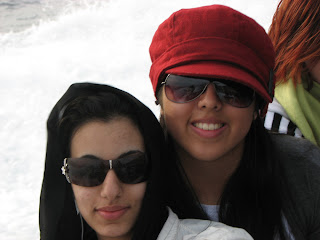October 6, 2010
As we neared the end of September, our students were taken on a tour of a local winery here in Abruzzo named Madonna Del Carmine. Mrs. D’Alessandro arranged the tour on our behalf and arranged for the wine maker to give an instructional tour of the winery. We witnessed the various stages from the grapes being brought in on trucks and wagons; to them being weighed; measured for sugar content; then dropped into a hopper that separated the stems and crushed the grapes; and then seeing how the juice is extracted, fermented and stored. At the end of the tour we were treated to a wine tasting which everyone enjoyed. It was a wonderful way to end the day on a Friday.
 |
| Now that is how to fill a wine bottle! |
An arm wrestling contest was held on Wednesday after school. Suffice to say that the teachers did not walk away with any of the hardware!
We have just returned from a two day trip that included Naples, Pompeii, Sorrento and Amalfi.
Built in the 17th C for the Bourbon King Charles III, the Palace Reale in Caserta (Naples) is Italy’s largest royal palace and the last example of Baroque architecture built on such a scale in all of Italy. After entering the massive entrance hall, the students were given a guided tour of the actual building looking in the throne room, the king’s private bedroom as well as other estate rooms. There are 1200 rooms here, not all of which are open for public viewing. Then we spent time in the massive gardens. There is water course from the mountains above that feeds chain of water works, fountains and statues that depict stories from mythology. All in all, the entire estate was impressive - just the objective that the architects and designers were seeking to achieve.
Equally impressive was Pompeii which was a leading cultural and trading town populated by wealthy Romans. It was destroyed in 79 A.D. after Mt. Vesuvius erupted in a series of explosions. The unfortunate citizens were either buried by collapsing buildings or suffocated where they were by poisonous gases. The town was encased in some 6 m of ash that soon hardened and preserved them until the town was discovered a few hundred years ago. It is a jewel that provides archaeologists and historians with a clear insight into the life and times of these ancient people.
We had two wonderful guides that taught us about how the people of Pompeii lived, how they designed their houses, how they designed their city, and what activities they were engaged in when they all suddenly died.
 |
| Admiring wall frescos in a Patrician's home |
Leaving Pompeii behind, we then drove down to Sorrento, a beautiful town that sits perched on cliffs above the sea. It is from this port that we boarded our chartered boat that took us down the rugged coastline past Positano to Amalfi.
On the way to Amalfi.
 |
| Positano |
Many of us remained in Amalfi – some to swim, some to shop, some to simply walk and take in the sites. A few others travelled by cab to the top to the small town of Ravello, a much quieter town that offered magnificent views of the Adriatic.
 |
| The View from Ravello |
We were all sad to leave these gorgeous towns that certainly live up to their reputation for beauty.



































Wonderful photos....thanks for share the trip
ReplyDeleteFanny